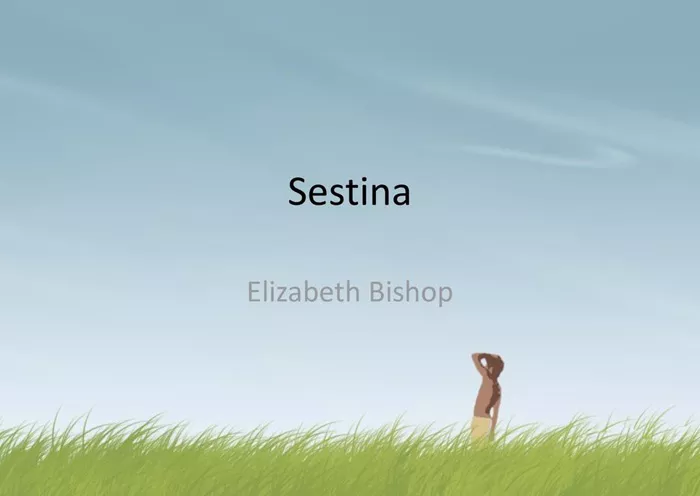Welcome to Poem of the Day – Sestina by Elizabeth Bishop
Elizabeth Bishop’s “Sestina” is a poignant and structured poem that showcases her mastery of form and emotional depth. In this article, we will explore the poem’s meaning, structure, and literary elements. Through clear explanations and analysis, we’ll delve into the emotional landscape Bishop paints in this classic work.
Sestina Explanation
Introduction to “Sestina”
Elizabeth Bishop’s “Sestina” was first published in 1956, a period when she was already recognized for her precise, yet emotionally rich poetry. The poem follows the intricate structure of a sestina, a form of poetry created by the 12th-century poet Arnaut Daniel and later perfected by Dante Alighieri. The structure is made up of six stanzas, each containing six lines. What makes the sestina unique is its pattern of word repetition at the end of the lines. The final word in the first stanza is repeated in a set order at the end of the lines in the following stanzas.
In Bishop’s poem, the use of form is not just a technical challenge but a means to deepen the emotional resonance of the subject matter: the speaker’s interaction with a young child and the pain of loss and grief that subtly underpins their relationship.
The Structure of the Poem
The poem adheres strictly to the sestina form. As mentioned, the structure requires each stanza to end with a specific set of words. In Bishop’s “Sestina,” the six end-words are: stove, flowers, tea, child, night, and moon. These words follow a set pattern in the succeeding stanzas, creating an almost hypnotic rhythm that reinforces the cyclical and recurring nature of the poem’s themes.
This technical challenge gives the poem a musical, almost incantatory feel, while also highlighting the repetitive nature of the emotions and events described.
Themes in the Poem
“Sestina” centers on themes of loss, memory, and the passage of time, yet it does so in a subtle and restrained way. The speaker describes a scene where a grandmother and her grandchild sit together on a rainy day, engaging in quiet, domestic activities. However, underlying this peaceful exterior is the sadness of the grandmother, who is clearly mourning the loss of a loved one. The poem conveys a sense of inevitability and cyclical loss, where the repetition of words mirrors the repetitive nature of grief.
The child, with their innocent perspective, notices the rain and the stars outside, yet the grandmother is preoccupied with memories of the past, a theme conveyed through the repetition of the word “moon.” The child is unaware of the full emotional weight of the situation, while the grandmother’s sorrow is almost tangible in her eyes. The symbols of the moon, flowers, and night, along with the structure of the poem, all point to the inevitability of life’s cycles—birth, death, and the constant movement of time.
Symbolism in “Sestina”
The symbols in the poem are rich and multi-layered. The moon, in particular, can be interpreted as a symbol of time, memory, and loss. The repetition of this symbol emphasizes the continuity of life and death. The stove, where the tea is being made, serves as a grounding, domestic symbol, representing warmth and nurturing. However, it is also a metaphor for the heat of the emotions that the grandmother feels, which she can’t quite express openly. The flowers, as a symbol of nature, represent life and growth, but in the context of the poem, they also allude to fragility and the fleeting nature of time.
The rain and the tea also stand as symbols of comfort in difficult times—yet these symbols are tinged with melancholy. They serve as temporary distractions from deeper emotional turmoil, much like the repetitive nature of the sestina form itself, which cycles through emotions without resolving them fully.
The Emotional Landscape
Bishop’s choice of words and structure creates a tight emotional atmosphere, underscoring the tension between the grandmother’s sadness and the child’s innocence. The poem opens with the grandmother’s attempt to hide her sorrow from the child, but the careful repetition of the end-words throughout the stanzas mirrors the grandmother’s unspoken grief. The child, unaware of this deeper sadness, clings to the mundane details of the day—the weather, the flowers, the tea.
The last stanza is particularly poignant. As the grandmother attempts to distract herself with practical tasks, the child is left with an unspoken understanding that something is amiss. The poem’s form allows the reader to experience the same cyclical feeling of loss and waiting that the characters within the poem feel. The quiet, circular repetition of words mimics the repetitive nature of daily life, which continues despite the emotional weight that lies just beneath the surface.
Conclusion
Elizabeth Bishop’s “Sestina” is a masterful poem that uses both form and content to explore complex emotions with clarity and precision. The strict structure of the sestina form mirrors the repeating cycles of grief, loss, and memory, while the vivid imagery and symbolism deepen the emotional resonance of the poem. Through the simple yet effective portrayal of a grandmother and child on a rainy day, Bishop captures a moment of quiet sadness that speaks to the universal experience of mourning and the passage of time.
“Sestina” is a perfect example of how form can enhance meaning in poetry. The interplay between the rigid structure and the emotional complexity of the content creates a work that resonates with readers long after they have finished reading it.


